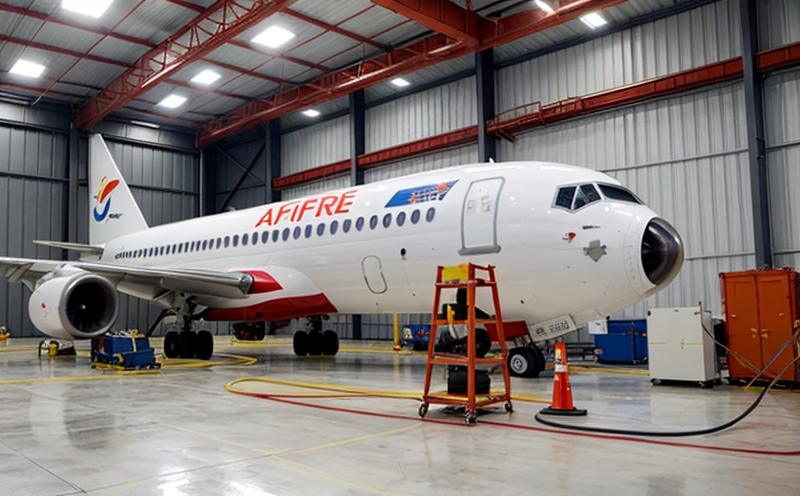Toxic Gas Emission Analysis of Burning Aircraft Materials
The aerospace industry is a critical sector that demands stringent quality and safety standards. Ensuring the materials used in aircraft are not only strong but also safe from a toxic gas emission standpoint is paramount to protect passengers, crew, and maintain operational integrity during emergencies.
One crucial aspect of this is the Toxic Gas Emission Analysis. This analysis involves evaluating the gases released when burning different aircraft materials under controlled conditions. The goal is to identify potential hazardous compounds that could be harmful in an enclosed space like an airplane cabin or cockpit. This service is vital for several reasons:
Firstly, it helps manufacturers ensure compliance with international standards such as ISO 16000-5 and ASTM E672, which are specifically designed to test the levels of toxic gases released by materials in a fire scenario.
Secondly, this analysis supports product development by identifying material combinations that can be used safely without compromising structural integrity. Lastly, it aids in meeting regulatory requirements set forth by aviation authorities like the Federal Aviation Administration (FAA) and European Union Aviation Safety Agency (EASA).
The process involves several steps starting with selecting representative samples of aircraft materials to ensure accurate results. These samples are then subjected to controlled combustion tests using equipment that simulates real-world fire scenarios in an aerospace environment.
After the test, various toxic gases including carbon monoxide, hydrogen cyanide, and acrolein among others are measured. The results provide detailed insights into which materials pose minimal risk and which might need modifications or replacement.
This service is essential not only for new product development but also during production to monitor quality consistency. By regularly performing this analysis, manufacturers can catch any issues early on before they become significant problems affecting both safety and reputation.
In summary, toxic gas emission analysis plays a crucial role in maintaining the highest standards of safety within the aerospace industry. It ensures not only compliance with regulatory requirements but also contributes significantly to enhancing overall aviation safety.
Applied Standards
| Standard | Description |
|---|---|
| ISO 16000-5 | This international standard outlines the procedures for measuring toxic gases released during a fire. It specifies sampling techniques, analytical methods, and data evaluation processes. |
| ASTM E672 | An American Society for Testing and Materials standard that provides guidelines on testing the flammability characteristics of materials used in aircraft interiors. |
| EN 455-1 | This European standard addresses the performance requirements and test methods for fire protective clothing. While not directly related to aircraft materials, it complements other standards by ensuring that materials withstand intense heat without releasing harmful gases. |
| FAR 25.853 | Part of the U.S. Federal Aviation Regulations, this regulation mandates smoke and toxicity tests for cabin interior materials in commercial aircraft. |
The chosen standards ensure consistency and reliability across different environments and jurisdictions. They provide a standardized approach to evaluating toxic gas emissions, making it easier for manufacturers to comply with global regulations while enhancing safety measures within the industry.
Scope and Methodology
The scope of this service encompasses comprehensive evaluation of all types of materials used in aircraft construction. This includes but is not limited to interior fabrics, seating upholstery, insulation foams, electrical wires, and structural components that could potentially catch fire.
The methodology involves several key steps:
- Sample Preparation: Representative samples are taken from the specified materials.
- Combustion Testing: Samples are subjected to controlled combustion tests using specialized equipment designed to simulate various fire scenarios relevant to aviation.
- Emission Measurement: Advanced analytical instruments measure the levels of toxic gases produced during the combustion process. This includes real-time monitoring and post-test analysis.
- Data Analysis: The collected data is thoroughly analyzed against established benchmarks provided by applicable standards like ISO 16000-5 and ASTM E672.
- Reporting: A comprehensive report summarizing findings, including potential risks identified, compliance status with relevant regulations, and recommendations for improvement if necessary.
This structured approach ensures accurate assessment of materials' toxicity levels under simulated fire conditions. It allows manufacturers to make informed decisions about material selection based on rigorous scientific testing rather than assumptions or guesswork.
Eurolab Advantages
At Eurolab, we pride ourselves on offering unparalleled expertise in aerospace fire safety testing. Our team of highly skilled professionals brings extensive experience to every project, ensuring that your requirements are met with precision and accuracy.
We have state-of-the-art facilities equipped with the latest technology required for conducting precise toxic gas emission analyses. This includes cutting-edge combustion chambers capable of simulating various types of fires relevant to aviation, along with sophisticated analytical instruments such as gas chromatography-mass spectrometry (GC-MS) systems.
Our commitment to quality extends beyond just technical capabilities; we also offer exceptional customer service and support throughout the entire process. From initial consultation to final report delivery, our dedicated staff will be there every step of the way to ensure smooth collaboration and timely completion of your projects.
Moreover, Eurolab stays at the forefront of industry trends through continuous training and updates on the latest standards and best practices in aerospace fire safety testing. This allows us to provide solutions tailored specifically to current regulatory requirements and emerging challenges faced by our clients.





